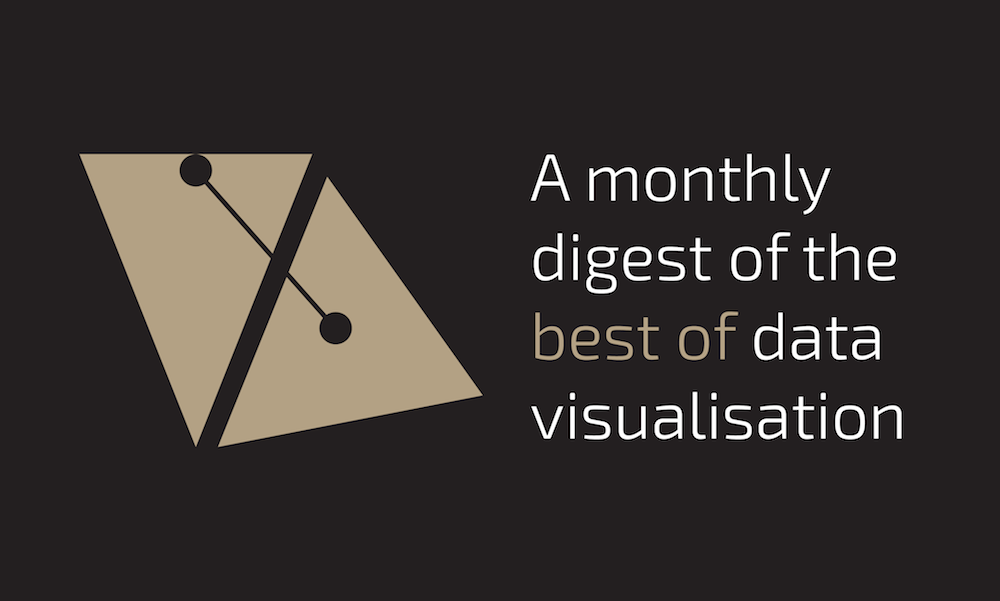At the end of each month I pull together a collection of links to some of the most relevant, interesting or thought-provoking web content I’ve come across during the previous month. Here’s the latest collection from November 2016.
Visualisations & Infographics
Includes static and interactive visualisation examples, infographics and galleries/collections of relevant imagery.
Washington Post | Inevitably, plenty of US election related visualisations this month, which I’ve covered in part elsewhere, so a few different ones… ‘Americans like XXX more than Hillary Clinton or Donald Trump’
Twitter | Perhaps the moment when the course of history was inverted
Bloomberg | ’58 Ways The Race Was Called’
Washington Post | ‘Bringing America together: Find the closest place that voted the opposite of where you live.’
New York Times | ‘Could Trump Really Deport Millions of Unauthorized Immigrants?’
Quartz | ‘10,000 words ranked according to their Trumpiness’
Washington Post | ‘How Trump won the presidency with razor-thin margins in swing states’
ProPublica | ‘Lost Cause: Seeing America Through the Losing Candidates’ Map’
Twitter | ‘Not sure there will ever be a more enduring chart…’
New York Times | ‘The Two Americas of 2016’
FiveThirtyEight | ‘No, Voter Turnout Wasn’t Way Down From 2012’
Twitter | ‘The Post’s A1, as it was developed.’
WSJ | ‘An Animated View of Election Night’
Washington Post | ‘Remix the Election: The results in sound’
Bloomberg | ‘The Bloomberg Politics Poll Decoder’
ProPublica | This was a great idea, ‘Electionland: Monitoring access to the vote in real time.’
LA Times | ‘The last time California tried to legalize weed it failed. What happened?’
Lisa Charlotte Rost | ‘The US Election 2016 in Popular Votes’
Arnold Platon | ‘What if: The EU had presidential elections like the USA’
The Rhythm of Food | ‘How do we search for food? Google search interest can reveal key food trends over the years.’
YouTube | ‘Is a scientific career predictable?’
Volkskrant | ‘1,000 Dagen Plastic’/’1,000 Days of plastic’
Nesta | ‘Bacteria vs. Antibiotics: The fight against antibiotic resistance across Europe’
Hilltop Analytics | ‘Football Analysts on Twitter: Visualisation of follower / following network for football analysis accounts on Twitter’
wbkd GitHub | A curated list of ‘the most outstanding examples of visual and interactive journalism’
Poynter | ‘Here’s (some of) the best political journalism of 2016’
Washington Post | ‘Map: The remarkable distances you can travel on a European train in less than a day’
Reddit | ‘Orientation of international borders by continent’
Elephant Atlas | Visualising ‘The Great Elephant Census’
Swiss Info | ‘The complete history of every No. 1 male tennis player’
Polygraph | ‘Twenty years of the NBA: Redrafted’
Robert Manduca | ‘Where Are The Jobs? Employment in America, 2014’
Articles
The emphasis on these items is that they are less about visualisation images and are more article-focused, so includes discussion, discourse, interviews and videos
New York Times | ‘There Are Many Ways to Map Election Results. We’ve Tried Most of Them.’
Cartonerd | and partly in response… ‘today’s HUGE map in the New York Times warrants some cartonerd attention’
Washington Post | More discussions about maps… ‘Election maps are telling you big lies about small things’
The Engine Room | ‘Dangerous data: The role of data collection in genocides’
Election Data | ‘How do you feel? Don’t ask.’
Stats in the Wild | ‘Silver wins Gold: Ranking the poll aggregators in the 2016 presidential election’
5W Blog | ‘The best world map projection?’
The Functional Art | ‘Now more than ever: Call out data and visualization bullshit’
Wired | ‘Trump’s Win Isn’t the Death of Data—It Was Flawed All Along’
FastCo Design | ‘What Designers Should Do Now’
HBR | ‘Why It’s So Hard for Us to Visualize Uncertainty’
FastCo Design | Some interesting points in this piece despite the unnecessary snarling tone, ‘Why We Had No Idea Trump Would Win: The data failed to predict Trump, and the design didn’t help.’
Learning & Development
These links cover presentations, tutorials, academic papers, development opportunities, case-studies, how-tos etc.
Fell in Love With Data | ’11 (Papers + Talks) Highlights from IEEE VIS’16′
Nature | ‘Cognitive and psychological science insights to improve climate change data visualization’ by Jordan Harold, Irene Lorenzoni, Thomas F. Shipley & Kenny R. Coventry
Darkhorse Analytics | ‘Data looks better naked: Maps edition’
Learning D3 | ‘Master D3 From the Ground Up: Learn how to build unique and interactive visualizations from scratch’
YouTube | ‘FiveThirtyEight’s data journalism workflow with R’
Darkhorse Analytics | ‘Visualization is not a straight path from vision to reality’
Subject News
Includes announcements within the field, brand new/new-to-me sites, new books and generally interesting developments.
Information is Beautiful Awards | A compilation of the 2016 award winners
Amazon | New Book: ‘Applying Color Theory to Digital Media and Visualization’ by Theresa-Marie Rhyne
Art Lab | Exhibition: ‘Datasquare, immersion into the big data’
Medium | ‘Dear Data has been acquired by MoMA, but this isn’t what we are most excited about.’
Uber GitHub | ‘deck.gl is a WebGL-powered framework for visual exploratory data analysis of large datasets.’
Telegraph | New to me, the Telegraph’s dedicated page for the collection of their team’s data journalism work
Sundries
Any other items that may or may not be directly linked to data visualisation but might have a data/technology focus or just seem worthy of sharing
Time | Time’s collection of 100 of the most influential photographs ever taken
A.I Experiments | ‘Introducing A.I. Experiments: Explore machine learning by playing with pictures, language, music, code, and more.’
Guardian | ‘Dictionary of 50,000 surnames and their origins published’
Figs | ‘Datalegreya is a typeface which can interweave data curves with text.’
Mousarris | ‘The ‘wave city’ coffee table bends a landscape of buildings in half, using the overlapping surface as the tabletop.’
WZ Chen | ‘The Only Probability Cheatsheet You’ll Ever Need’

